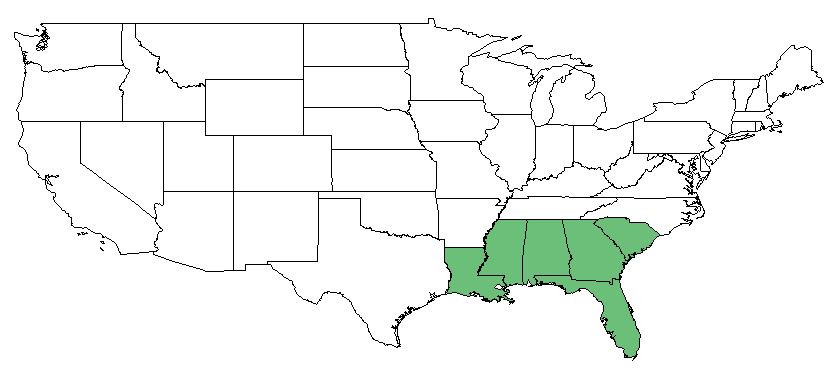Difference between revisions of "Collinsonia punctata"
(→Taxonomic Notes) |
|||
| Line 30: | Line 30: | ||
==Ecology== | ==Ecology== | ||
===Habitat=== <!--Natural communities, human disturbed habitats, topography, hydrology, soils, light, fire regime requirements for removal of competition, etc.--> | ===Habitat=== <!--Natural communities, human disturbed habitats, topography, hydrology, soils, light, fire regime requirements for removal of competition, etc.--> | ||
| − | < | + | ''C. punctata'' is found in rich woods.<ref name="Weakley 2015"/> |
| + | |||
| + | ===Phenology=== <!--Timing off flowering, fruiting, seed dispersal, and environmental triggers. Cite PanFlora website if appropriate: http://www.gilnelson.com/PanFlora/ --> | ||
| + | In the southeastern and mid-Atlantic United States, flowering occurs in late August to mid-October and fruiting from September through October.<ref name="Weakley 2015"/> | ||
<!--===Seed dispersal===--> | <!--===Seed dispersal===--> | ||
<!--===Seed bank and germination===--> | <!--===Seed bank and germination===--> | ||
<!--===Fire ecology===--> <!--Fire tolerance, fire dependence, adaptive fire responses--> | <!--===Fire ecology===--> <!--Fire tolerance, fire dependence, adaptive fire responses--> | ||
| − | <!--===Pollination===--> | + | <!--===Pollination===--> |
===Use by animals=== <!--Herbivory, granivory, insect hosting, etc.--> | ===Use by animals=== <!--Herbivory, granivory, insect hosting, etc.--> | ||
Revision as of 14:49, 15 February 2018
| Collinsonia punctata | |
|---|---|
Error creating thumbnail: Unable to save thumbnail to destination
| |
| Photo by from USDA NRCS Plants Database. | |
| Scientific classification | |
| Kingdom: | Plantae |
| Division: | Magnoliophyta - Flowering plants |
| Class: | Magnoliopsida - Dicots |
| Order: | Lamiales |
| Family: | Lamiaceae |
| Genus: | Collinsonia |
| Species: | C. punctata |
| Binomial name | |
| Collinsonia punctata Walter | |

| |
| Natural range of Collinsonia punctata[1] | |
Common Names: Florida horsebalm;[2] blue ridge horsebalm;[3]
Contents
Taxonomic Notes
Synonym: C. serotina;[2][3] C. canadensis var. punctata; Hypogon verticillata; Micheliella anisata[3]
The taxanomic identification of this species seems highly debated in the literature.[4] Collinsonia punctata is almost identical to Collinsonia anisata except for its different scent and the number of stamen (two).[5][6] In a 2006 manuscript, C. punctata is recognized as having two stamens instead of four and being an intermediate between C. canadensis and Collinsonia anisata.[4]
Description
Collinsonia serotina is a dioecious perennial forb/herb.[3]
Distribution
Ecology
Habitat
C. punctata is found in rich woods.[2]
Phenology
In the southeastern and mid-Atlantic United States, flowering occurs in late August to mid-October and fruiting from September through October.[2]
Use by animals
C. serotina composes 2-5% of the diet for some terrestrial birds.[7]
Conservation and Management
Cultivation and restoration
Photo Gallery
References and notes
- ↑ Weakley, Alan S. 2015. Flora of the Southern and Mid-Atlantic States: Working Draft of 21 May 2015. University of North Carolina, Chapel Hill, North Carolina. 1320 pp.
- ↑ 2.0 2.1 2.2 2.3 Weakley AS (2015) Flora of the Southern and Mid-Atlantic States. Chapel Hill, NC: University of North Carolina Herbarium.
- ↑ 3.0 3.1 3.2 3.3 USDA NRCS (2016) The PLANTS Database (http://plants.usda.gov, 15 February 2018). National Plant Data Team, Greensboro, NC 27401-4901 USA.
- ↑ 4.0 4.1 Peirson JA, Cantino PD, Ballard, Jr. HE (2006) A taxonomic revision of Collinsonia (Lamiaceae) based on phenetic analyses of morphological variation. Systematic Botany 31(2):398-409.
- ↑ Sims J (1809) Collinsonia anisata Curtis's Botanical Magazine 30:t.1213.
- ↑ Ward DB (2014) Thomas Walter typification project, VII: Observations on the genus Collinsonia (Labiatae) and a neotype for C. serotina Walter. Phytoneuron 89:1-5.
- ↑ Miller JH, Miller KV (1999) Forest plants of the southeast and their wildlife uses. Southern Weed Science Society.